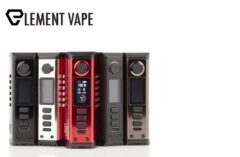Table of Contents
Last Updated on April 16, 2024 by Team Spinfuel
Fuchai 213 by Sigelei – A Review
The first thing most knowledgeable vapers will want to know about the Fuchai 213 is, “What’s the difference between the Sigelei 213 and the Sigelei Fuchai 213?” The shortest answer is “Not much”, by why stop there. Let’s get specific.
DISCLAIMER: Our review for the Sigelei 213 was based on a pre-release unit. Since I reviewed that version I cannot honestly tell you anything about the current controversy. I can, and do, mention Sigelei’s response to the controversy, but I will not take anecdotal accounts as fact.
Because both mods are made by Sigelei, they look very much alike, they both top out at 213 watts, at least when hitting off fully charged dual 18650 batteries. The Sigelei 213 was released just a few months ago, and it is well worth considering why Sigelei felt the need to release a very similar mod under the Fuchai line. I will discuss this, and much more, in this brand new review for one of my favorite mods.
The Sigelei 213 still sells for a modest $99 (modest because of the rich feature set and quality materials), while the Fuchai 213 sells for less, $76.95 at Element Vape. So, what then is the total difference?
As far as I can tell, the only outer body casing differences between the Sigelei 213 and Fuchai 213 is the materials, an aluminum alloy material and accented aluminum space frame trimmings versus Carbon Fiber and Zinc alloy. Sigelei manufactured the Fuchai 213 for affordability, and made a few minor tweaks in the feature set. The specs from both are 99% the same.
Previous Model: Sigelei 213W TC Box Mod Features:
- Dual 18650 High-Amp Battery – Not Included
- Wattage Output Range: 10~213W
- Voltage Output Range: 1~7.5V
- Output Max Current: 35A
- Intuitive 0.91 Inch OLED Display
- Premium Carbon Fiber and Zinc Alloy
- Black Carbon Fiber and Gold Trim
- Power Up Functionality
- Ni200, Titanium, and Stainless Steel Compatibility
- Technology Similar to Temperature Coefficient of Resistance (TCR)
- Three-Button Operation
- Magnetized Pop-Up Battery Door
- MicroUSB Port for charging only
- Spring-Loaded 510 Connection
Angry buyers of the Sigelei 213 base their anger, as far as I can tell, on the TCR-like function, rather than a full blown TCR feature, and how, with some super voodoo math, which I really don’t feel qualified to talk about, that has something to do with Sigelei using Fahrenheit instead of Celsius when calculating temperature control. The new Fuchai 213 is supposed to be based on Celsius when it calculates temperatures. Either way, I don’t find either one a real problem. There is also an issue about Firmware Upgrades, and I’ll get to that below.
What I know is that both the Sigelei 213 and Fuchai 213 give me a great vape experience, so unless you are a very advanced vaper where even a couple of degrees’ difference can ruin your experience, I guess I just don’t see anything that would prevent me from buying either one.
When it comes to my vaping, it’s never been about numbers and calculating anyway, it’s been about adjusting the
meaningless numbers (meaningless to me) until my vape felt right. I’m not criticizing those that love all the tiny details of every mod they own. These super advanced vapers drive the industry toward better and better devices for people like me and you, people who just want a great looking device capable of driving any atomizer I attach to it with good performance. I applaud the super advanced vaper for their efforts, and I wish them much luck in this, and future issues with mods from China.
Trying to Think like Sigelei
Looking back at all the Sigelei products I’ve owned, and several that I have reviewed, it has always seemed to me that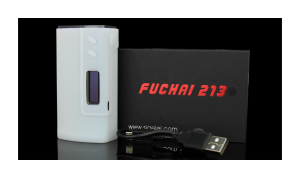
Sigelei designs mods for Intermediate vapers, not necessarily the super advanced vapers, which is why, I really believe, there has been so much discussion about TFR, using Fahrenheit in their calculations instead of Celsius, and firmware upgrades on the release versions of the Sigelei 213. So, if you’re interested in going down that rabbit hole I would suggest searching some vape forums where you’re certain to find many discussions over both the 213 and Fuchai 213.
Tackling the Firmware Upgrade Process Issue
Sigelei never claimed that the Sigelei 213 was or is, “Firmware Upgradable”. This “feature” was added onto the Official Specs by an online vendor and then picked up by everyone else. According to Sigelei, this was never a feature. In fact, in my prerelease unit the manual does not mention firmware upgrades.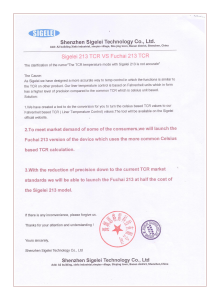
On April 29th, 2016 Sigelei posted this popup on their Sigelei.com website: (I am posting it as it is on the website, spelling and grammar is left intact.)
———–
The clarification of the rumor “The TCR temperature mode with Sigelei 213 is not accurate”
The Cause:
As Sigelei we have designed a more accurate way to temp control in which the functions is similar to the TCR on other product. Our liner temperature control is based on Fahrenheit units which in form has a higher level of precision compared to the common TCR which is celsius unit based.
Solution:
1.We have created a tool to do the conversion for you to turn the celsius based TCR values to our Fahrenheit based TCR (Liner Temperature Control) values. The tool will be available on the Sigelei official website. http://www.sigelei.com/tcr.php
2.To meet market demand of some of the consumers, we will launch the Fuchai 213 version of the device which uses the more common Celsius based TCR calculation.
3.With the reduction of precision down to the current TCR market standards we will be able to launch the Fuchai 213 at half the cost of the Sigelei 213 model.
—–
My Commentary Concerning This Popup
It is absolutely true that Sigelei never posted on their website that the Sigelei 213 was “firmware upgradeable”. Our
initial review for the device never used the word “firmware”. If you wanted to be angry with Sigelei I suppose you could be angry that they did not make that more obvious, and/or make the Fahrenheit issue more obvious. But let’s face it; we’re dealing with China, and if you know recent history about China than you know that there is a demand for “capitalism, profit by any means capitalism. Something we’ve not had in decades.” Since when in the US or UK is “caveat emptor” the law of the land? It is in China.
As for the half-price nonsense, as you can see on any online vendor shop the Fuchai 213 didn’t turn out to be half the price of the Sigelei 213. If Sigelei meant “wholesale cost” then it is the vendors that decided to take the price up to $75. But, my gut tells me that Sigelei overestimated their ability to build the Fuchai 213 and have it cost half of what the older 213 cost. I’m sure Sigelei or any other Chinese manufacturer place profit above something they said to calm down angry customers. Whatever, even at $75 it’s an excellent price for what you get, based on today’s market.
Note* I am certainly not anti-China, economically speaking, because of the Western world leader’s ignorance of the future, China owns the world. Their business practices may seem different than our own, the truth is the US had the same type of capitalism in the 19th and 20th century.
Enough, let’s move on to the Fuchai 213 review.
Body Styling
Holding both the 213 and Fuchai 213 in my hands, the size, button positions, battery cover, display, etc., are exactly the same on both models. The OLED display is the same, all the information laid out the same in both models… largest information on the display is the Wattage/Temperature, underneath is white on black “mode” indicator, battery life indicator bar, then up the right side of the display is the amperage output, voltage output, and ohms reading, all in real time under load. Plus, you can set up to 5 memory slots for TCR settings to be used when swapping out atomizers or tanks.
Battery cover on the bottom has a release hatch which, when opened, allows easy access to the two battery compartment. USB port for charging and firmware upgrading.
Official Specs from Sigelei.Com for the Fuchai 213
- 213W Maximum Output Wattage
- 10 to 213W
- 1.0 to 7.5V
- 0.1 to 3.0-ohm Atomizer Resistance Range
- 35A Maximum Output
- Preheat Power Mode
- Set Output Wattage and Time
- Temperature Control – Ni200 Nickel Support – Titanium Support -Stainless Steel Support (304 – 316 – 317 SS)
- TCR Functionality – Temperature Coefficient of Resistivity
- TFR Functionality – Temperature Factor of Resistivity
- Resistance Read and Lock
- 5 Coil Memory Bank
- 200 to 570 Degrees Fahrenheit
- Sliding and Locking Bottom Battery Access Door
- Accepts Two 18650 Batteries (sold separately)
- Ergonomically Placed Controls
- One Hand Operation
- Adjustment Buttons Clustered Next to Firing Button
- OLED Display – Four Row, Three Column Display – Atomizer Resistance – Output Voltage – Output Current – Battery State and Battery Life Indicator – Output Wattage – Output Temperature
- Micro USB Charge and Update Port
- 2A Maximum Charge Rate
- Curved Chassis
- Aluminum Alloy Chassis
- Stainless Steel 510 Connection
- Spring Loaded Gold Plated Connection
- High Input Voltage/Reverse Battery/Low Resistance/Battery Imbalance/Low Input Voltage/Short Circuit/Overheating Protection
As far as I’ve been able to learn, the Fuchai 213 uses the same chipset, the SGL1605V1.5. developed by Sigelei to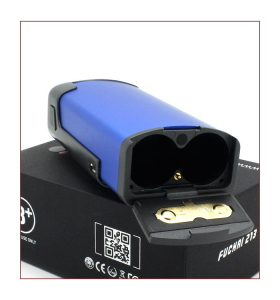
power the Fuchai 213, though because of the tweaks to Celsius, the chipset could be different.
The Fuchai 213 also supports the superfast ‘balanced’ onboard charging, capable of charging both batteries at 2A each. You’ll need a wall adapter for the included USB cable for get the full 2A charging mode.
Atomizers Used with the Fuchai 213
Like I did with the Sigelei 213, I ran through a lot of different atomizers looking for great performance and a flush sit. The spring loaded connector made the flush fit part pretty easy, and every atomizer I threw at it worked without a problem.
One in particular produced not only a great performance, but it also looked fantastic sitting atop the device. That atomizer is the new SMOK TFV8, or Cloud Beast. (sits perfectly flush to the device as well)
The Cloud Beast by SMOK is a humongous tank. After opening the box on my first SMOK TFV8 I got a bit nervous. Looking at the coil heads that come with this monster sized tank made me nervous. These coil heads are huge, and incredibly powerful. (In the back of my mind I am always thinking do we need a tank like this. I do love the performance, but God it’s scary looking.)
The Cloud Beast TFV8 holds 6mL of ejuice, despite its enormous size coil head. It’s also 24mm in diameter, which will overhang on many mods, but not the Fuchai 213.
For finding out how well the Fuchai 213 could handle an atomizer like this I used the V8-T8 Coil, which is rated at 50-260 Watts, with a sweet spot for my e-juices somewhere in the 80-140W area, depending solely on the thickness of the juice. Because the Fuchai 213 can race up to 213-watts on a full charge, I figured they could work well together. (I’ll have my review of the TFV8 in the next day or two).
Once I filled and primed the TFV8 it was time to begin the vape test. Briefly, this was the outcome at various wattage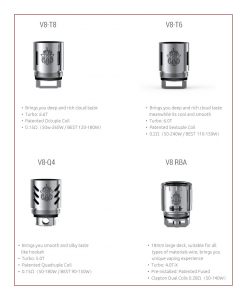
settings. (I used Wattage mode exclusively)
I began at 40-watts – Not even a spark. At 50 watts, with MaxVG eliquid, I got very little vapor, and the flavor seemed to come from the aroma of the juice rather than the power of vaporizing the ejuice.
Seeing as how the Cloud Beast was going to need some serious power I pushed the Fuchai 213 to 80w, and the result was a decent amount of both flavor and vapor, but the vapor was cool. It needed more power.
So I pushed the Fuchai 213 to 100w and then things began to happen. Incredible vapor, amazing flavor. Then 120w, even more goodness from the juice. Then, lastly, 140 and 160 watts, at that point it was all flavor and vapor like I’d never seen before. At 160 the vapor was very warm, but not too warm. At 180 watts the vapor was right on the edge, certainly warm enough for the coldest mornings in New Hampshire, but too warm to vape very long… for my best vape.
The Fuchai 213 and the TFV8
Okay, so the TFV8 with the V8 coil head performed extremely well with the Fuchai 213, but how did the Fuchai 213 handle the job? Just as important, how did the Sigelei 213 hold up to the TFV8? I thought this might be a perfect time to see if the Sigelei 213’s carbon fiber casing did a better job with heat dissipation. I ran the Cloud Beast TFV8 tests on the Sigelei 213 with pretty much the same results.
Battery Life with the 213’s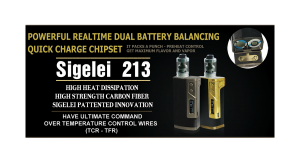
Vape any atomizer above 80 watts and you’re going to see battery life decrease quickly. In fact, I seriously doubt either of the 213’s would last more than 15 minutes at 210-watts. As the battery drains hitting those magic marks, like 213 watts, becomes impossible, no matter how good the chipset works. In a triple 18650 mod you might get another 5 minutes at full wattage output.
Vaping between 80w and 120 watts was most comfortable for me, and I vaped through the 6mL of ejuice on both mods in 20 minutes. I took pulls on the wide-bore drip tip about 1.5 times a minute, maybe a little more at times.
Heat Dissipation on the 213’s
The Sigelei 213 did a slightly better job with holding off the heat than the Fuchai 213. I’m almost definite that the carbon fiber casing was the reason. However, both units never got too warm, and I was never in fear of any sort of overheating.
When both the Sigelei 213 and the Fuchai 213 are left to sit for any amount of time, the Fuchai 213’s aluminum outer casing is much cooler to the touch than the carbon fiber of the Sigelei 213.
At the same time, at high wattage the aluminum casing will get warmer than the carbon fiber, which was originally developed for heat protection, lightweight and strength. Though the Aluminum alloy made for the Fuchai 213 did not perform badly at all.
The Bottom Line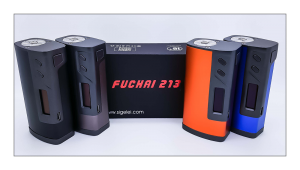
After using both the Sigelei 213 and the Fuchai 213 during this review period I am still somewhat confused why Sigelei thought they had to build the Fuchai model. I understand that they wanted to be able to upgrade the Fuchai 213, and that they wanted to satisfy customers who were unhappy with Temp Control based on Fahrenheit calculations, and firmware updates with the Sigelei 213, but it would seem to me that in order to not confuse the market, they would make other cosmetic changes than just dropping carbon fiber in favor of aluminum alloy, in order to distinguish the two convincingly.
One of the reasons I love the Sigelei 213 is body shape, location of the firing button and adjustment buttons, and the awesome colors that are available. I would never vape anywhere near 213 watts, so that was never a factor. The thing is, although I’m a big fan of carbon fiber mods, going all the way back to the Aspire CF batteries, I would happily use the Fuchai 213, especially if I was watching my vape budget.
I gave the Sigelei 213 the grade of A+. The Fuchai 213 has to receive the same grade, A+. Remove the carbon fiber feature and drop the price, and with its corrections in the Temp Control and firmware updates, it evens out. Lastly, unlike the Sigelei 213, the Fuchai 213 came with a silicon sleeve. I’m not aware that the release version of the 213 had a silicon sleeve, but my prelease unit did not.
Grade: A+
“One of the better box mods on the market today. Sophisticated electronics, power up technology, 213 watts with just two 18650 cells, with awesome colors laid over an aluminum body, the Fuchai 213 box mod can handle any atomizer you throw at it. The combination of the Fuchai 213 and the TFV8 Cloud Beast by SMOK make for a most serious, competition level vaping. Recommended to any intermediate or advanced vaper looking for power, Temp Control, and good looks.”
Tom McBride
PS: Both the 213 and the Fuchai 213 come with 2x 18650 batteries from Element Vape.







